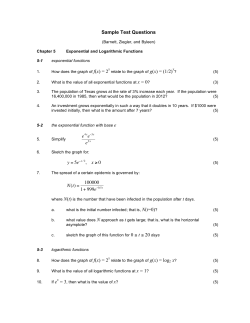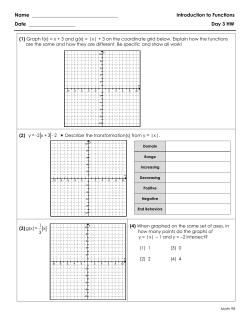
Graphing Logarithms on Desmos
Graphing Logarithms on Desmos * You can work with a partner but you must submit individual work.* Instructions: Each student will answer the following questions on a separate piece of paper. Copy all of your Desmos graphs onto a piece of graphing paper. Make sure to label and/or color code the different graphs. 1) a. Graph y = log 2 x . (You’ll need to convert it to exponential form.) Label at least three points on the graph, including the x-‐intercept. b. Graph y = log10 x . Label at least three points on the graph, including the x-‐intercept. c. Now choose your own b-‐value and graph y = log b x . Label at least three points on the graph, including the x-‐intercept. 2) a. How does the b-‐value affect the shape of logarithmic graphs? For example, how do the graphs change as b increases? b. Why is the x-‐intercepts of logarithmic functions in y = log b x form always at (1 , 0)? c. Why is the line x = 0 always a vertical asymptote (that is, a vertical line that the logarithmic graphs approach but never cross.) d. What happens to the graphs as the x-‐values increase? Do the graphs have a horizontal asymptote? 3) a. Graph y = log 2 (x) + 3 . (You’ll need to convert it to exponential form.) State the domain and range. b. Graph y = log 2 (x ! 2) . State the domain and range. c. Compare these transformed graphs to their parent graph y = log 2 x . d. Find and state the general equation of logarithmic functions. 4) a. b. c. Graph the exponential function y = 2 x . This function represents “exponential growth”. Find and graph the inverse function of y = 2 x . How can you check that you’ve found the correct inverse? Compare and contrast the exponential function y = 2 x and the logarithmic function y = log 2 x . For example, how are the domain and range of these functions different? 1 5) a. Graph the exponential function y = ( ) x . This function represents 2 “exponential decay”. 1 b. Find and graph the inverse function of y = ( ) x . 2 1 6) a. Compare and contrast y = 2 x and y = ( ) x . Why do you think the first is 2 called “exponential growth” and the second is called “exponential decay”?
© Copyright 2025





















